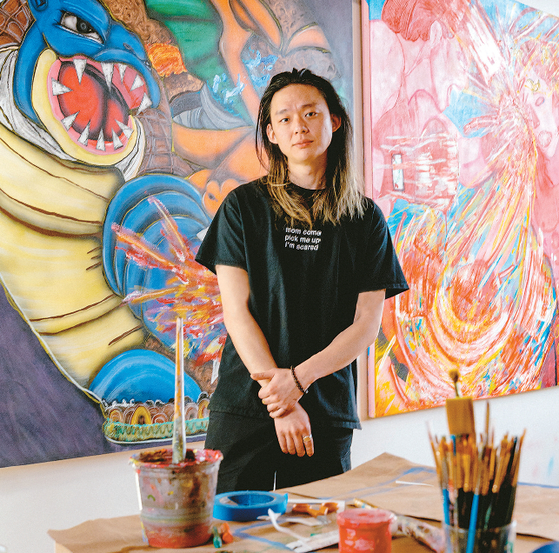
Right next to it, another painting of the same size titled “Rodney” is exhibited. Heo, an MFA graduate of the School of the Art Institute of Chicago, utilizes his artwork to express his sense of identity and convey messages about social issues. He is gaining recognition as an emerging artist in the contemporary art industry. The Korea Daily had an interview with Heo about his artistic journey.
-What motivated you to paint ‘Saigu’?
“My birthday is also ‘April 29, 1992.’ [Saigu refers to April 29 in Korean.] Since I was young, my mother would celebrate the day with me but also remind me that it was a tragic day for Korean-Americans like us. At the time, ‘Saigu’ was just a historical event to me. However, as time went on, I realized how deeply racism, discrimination, and classism against Asians are embedded in American society. ‘Saigu’ is a work of historical exploration based on this social phenomenon.”
-Was there a specific moment when you realized the severity of racism?
“It was the George Floyd case, which overlaps with the Rodney King case that sparked ‘Saigu.’ For me, ‘Saigu’ is no longer just history; it is my reality. It happened 31 years ago, but the circumstances and catalysts remain the same.”
-How does your identity reflect or influence your work?
“I’m like a Neapolitan ice cream, a combination of three flavors. My parents were immigrants who moved to Texas in the 1980s. They later gave birth to me in Georgia. I learned about Korean traditions and cultures at home and Southern culture and beliefs at school. After graduating from high school, I moved to Chicago. These diverse backgrounds have shaped who I am today. Additionally, Chicago, known as the City of Big Shoulders, reminds me of my parents’ lives as immigrants, with hardworking laborers and merchants. I draw inspiration for my work from my diverse background.”
-As a 90s-born artist, how do you make your art relatable?
“In sociology, the term ‘Third Culture Kids’ (TCKs) has recently emerged. TCKs occupy a unique position in society. They don’t fully identify with their parents’ generation’s culture and are simultaneously encouraged to assimilate into mainstream culture. However, even in the mainstream, they are labeled as ‘different.’ This leaves TCKs feeling adrift and in a kind of ‘gray area.’ As a Korean-American myself, I am on a quest to understand what ‘third culture’ means to me. More and more generations are experiencing TCK status, and it will be an important theme in my future work.”
-How did you start your journey in art?
“Like most immigrants, my parents were not thrilled about me becoming an artist. They wanted me to pursue a major in law or medicine. So, it wasn’t until high school that I began to seriously pursue art education. It was not an easy path to embark on. I enjoy challenging myself through my work. I aspire to live a creative life, even if it requires intentionality. Of course, I am frequently reminded that I am a full-time artist, and sometimes, imposter syndrome gets the best of me. But I remind myself that this is what I have dreamed of since I was a child. My aspiration is to continue dreaming and keep this awareness alive.”
BY YEOL JANG [support@koreadaily.com]




